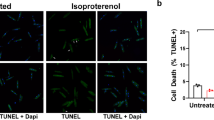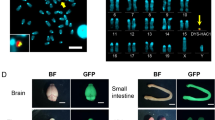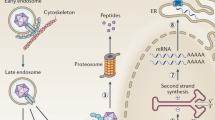Abstract
Intracardiac gene transfer and gene therapy have been investigated with different vector systems. Here we used adeno-associated virus (AAV) vectors to deliver either a reporter gene or a therapeutic gene into the heart of golden Syrian hamsters. The method of gene delivery was direct infusion of the AAV2 vectors into the coronary artery ex vivo in a heterotopically transplanted heart. When an AAV2 vector carrying the Lac-Z gene driven by CMV promoter was delivered into the heart of healthy hamsters, effective gene transfer was achieved in up to 90% of the cardiomyocytes. Lac-Z gene expression persisted for more than 1 year without immune rejection or promoter shutoff. Furthermore, when an AAV2 vector carrying human δ-sarcoglycan gene was similarly delivered into the heart of Bio14.6 Syrian hamster, a congestive heart failure and limb girdle muscular dystrophy animal model, widespread therapeutic gene transfer was achieved in a majority of the cardiomyocytes. Efficient expression of the human δ-sarcoglycan gene in the dystrophic hamster hearts restored the entire sarcoglycan complex that was missing due to the primary deficiency of δ-sarcoglycan. Transgene expression persisted for 4 months (the duration of the study) without immune rejection or promoter shutoff. These results indicate that AAV is a promising vector system for cardiac gene therapy.
This is a preview of subscription content, access via your institution
Access options
Subscribe to this journal
Receive 12 print issues and online access
$259.00 per year
only $21.58 per issue
Buy this article
- Purchase on Springer Link
- Instant access to full article PDF
Prices may be subject to local taxes which are calculated during checkout




Similar content being viewed by others
References
Harvey BG et al. Safety of local delivery of low- and intermediate-dose adenovirus gene transfer vectors to individuals with a spectrum of morbid conditions. Hum Gene Ther 2002; 13: 15–63.
Ikeda Y et al. Restoration of deficient membrane proteins in the cardiomyopathic hamster by in vivo cardiac gene transfer. Circulation 2002; 105: 502–508.
Losordo DW et al. Gene therapy for myocardial angiogenesis: initial clinical results with direct myocardial injection of phVEGF165 as sole therapy for myocardial ischemia. Circulation 1998; 98: 2800–2804.
Xie Q et al. The atomic structure of adeno-associated virus (AAV-2), a vector for human gene therapy. Proc Natl Acad Sci USA 2002; 99: 10405–10410.
Kaplitt MG et al. Long-term gene expression and phenotypic correction using adeno-associated virus vectors in the mammalian brain. Nat Genet 1994; 8: 148–154.
Ponnazhagan S et al. Adeno-associated virus 2-mediated gene transfer in vivo: organ-tropism and expression of transduced sequences in mice. Gene 1997; 190: 203–210.
Xiao W et al. Adeno-associated virus as a vector for liver directed gene therapy. J Virol 1998; 72: 10222–10226.
Flotte TR et al. Stable in vivo expression of the cystic fibrosis transmembrane conductance regulator with an adeno-associated virus vector. Proc Nat Acad Sci USA 1993; 90: 10613–10617.
Xiao X, Li J, Samulski RJ . Efficient long-term gene transfer into muscle tissue of immunocompetent mice by adeno-associated virus vector. J Virol 1996; 70: 8098–8108.
Kessler PD et al. Gene delivery to skeletal muscle results in sustained expression and systemic delivery of a therapeutic protein. Proc Nat Acad Sci USA 1996; 93: 14082–14087.
Ali RR et al. Gene transfer into the mouse retina mediated by an adeno-associated viral vector. Hum Mol Genet 1996; 5: 591–594.
Flannery JG et al. Efficient photoreceptor-targeted gene expression in vivo by recombinant adeno-associated virus. Proc Nat Acad Sci USA 1997; 94: 6916–6921.
Cordier L et al. Rescue of skeletal muscles of gamma-sarcoglycan-deficient mice with adeno-associated virus-mediated gene transfer. Mol Ther 2000; 1: 119–129.
Li J et al. rAAV vector-mediated sarcogylcan gene transfer in a hamster model for limb girdle muscular dystrophy. Gene Therapy 1999; 6: 74–82.
Xiao X et al. Full functional rescue of a complete muscle (TA) in dystrophic hamsters by adeno-associated virus vector-directed gene therapy. J Virol 2000; 74: 1436–1442.
Wang B, Li J, Xiao X . Adeno-associated virus vector carrying human minidystrophin genes effectively ameliorates muscular dystrophy in mdx mouse model. Proc Natl Acad Sci USA 2000; 97: 13714–13719.
Watchko J et al. Adeno-associated virus vector-mediated minidystrophin gene therapy improves dystrophic muscle contractile function in mdx mice. Hum Gene Ther 2002; 13: 1451–1460.
Greelish JP et al. Stable restoration of the sarcoglycan complex in dystrophic muscle perfused with histamine and a recombinant adeno-associated viral vector. Nat Med 1999; 5: 439–443.
Chao H et al. Persistent expression of canine factor IX in hemophilia B canines. Gene Therapy 1999; 6: 1695–1704.
Kay MA et al. Evidence for gene transfer and expression of factor IX in haemophilia B patients treated with an AAV vector. Nat Genet 2000; 24: 257–261.
Song S et al. Sustained secretion of human alpha-1-antitrypsin from murine muscle transduced with adeno-associated virus vectors. Proc Natl Acad Sci USA 1998; 95: 14384–14388.
Fraites Jr TJ et al. Correction of the enzymatic and functional deficits in a model of Pompe disease using adeno-associated virus vectors. Mol Ther 2002; 5: 571–578.
Hoffman EP . Counting muscular dystrophies in the post-molecular census. J Neurol Sci 1999; 164: 3–6.
Lim LE, Campbell KP . The sarcoglycan complex in limb-girdle muscular dystrophy. Curr Opin Neurol 1998; 11: 443–452.
Crosbie RH et al. Sarcospan, the 25-kDa transmembrane component of the dystrophin–glycoprotein complex. J Biol Chem 1997; 272: 31221–31224.
Homburger F, Baker JR, Nixon CW, Whitney R . Primary, generalized polymyopathy and cardiac necrosis in an inbred line of Syrian hamsters. Med Exp 1962; 6: 339–345.
Nigro V et al. Identification of the Syrian hamster cardiomyopathy gene. Hum Mol Genet 1997; 6: 601–607.
Sakamoto A et al. Both hypertrophic and dilated cardiomyopathies are caused by mutation of the same gene, delta-sarcoglycan, in hamster: an animal model of disrupted dystrophin-associated glycoprotein complex. Proc Nat Acad Sci USA 1997; 94: 13873–13878.
Holt KH et al. Functional rescue of the sarcoglycan complex in the BIO 14.6 hamster using delta-sarcoglycan gene transfer. Mol Cell 1998; 1: 841–848.
Kawada T et al. Rescue of hereditary form of dilated cardiomyopathy by rAAV-mediated somatic gene therapy: amelioration of morphological findings, sarcolemmal permeability, cardiac performances, and the prognosis of TO-2 hamsters. Proc Natl Acad Sci USA 2002; 99: 901–906.
Ono K, Lindsey ES . Improved technique of heart transplantation in rats. J Thorac Cardiovasc Surg 1969; 57: 225–229.
Pruchnic R et al. The use of adeno-associated virus to circumvent the maturation-dependent viral transduction of muscle fibers. Hum Gene Ther 2000; 11: 521–536.
Huard J et al. The basal lamina is a physical barrier to herpes simplex virus-mediated gene delivery to mature muscle fibers. J Virol 1996; 70: 8117–8123.
Kaplitt MG et al. Long-term gene transfer in porcine myocardium after coronary infusion of an adeno-associated virus vector. Ann Thorac Surg 1996; 62: 1669–1676.
Hoshijima M et al. Chronic suppression of heart-failure progression by a pseudophosphorylated mutant of phospholamban via in vivo cardiac rAAV gene delivery. Nat Med 2002; 8: 864–871.
Asfour B et al. Uniform long-term gene expression using adeno-associated virus (AAV) by ex vivo recirculation in rat-cardiac isografts. Thorac Cardiovasc Surg 2002; 50: 347–350.
Asfour B et al. A simple new model of physiologically working heterotopic rat heart transplantation provides hemodynamic performance equivalent to that of an orthotopic heart. J Heart Lung Transplant 1999; 18: 927–936.
Summerford C, Samulski RJ . Membrane-associated heparan sulfate proteoglycan is a receptor for adeno-associated virus type 2 virions. J Virol 1998; 72: 1438–1445.
Summerford C, Bartlett JS, Samulski RJ . AlphaVbeta5 integrin: a co-receptor for adeno-associated virus type 2 infection. Nat Med 1999; 5: 78–82.
Qing K et al. Human fibroblast growth factor receptor 1 is a co-receptor for infection by adeno-associated virus 2. Nat Med 1999; 5: 71–77.
Coral-Vazquez R et al. Disruption of the sarcoglycan–sarcospan complex in vascular smooth muscle: a novel mechanism for cardiomyopathy and muscular dystrophy. Cell 1999; 98: 465–474.
Cohn RD et al. Prevention of cardiomyopathy in mouse models lacking the smooth muscle sarcoglycan–sarcospan complex. J Clin Invest 2001; 107: R1–R7.
Xiao X, Li J, Samulski RJ . Production of high-titer recombinant adeno-associated virus vectors in the absence of helper adenovirus. J Virol 1998; 72: 2224–2232.
Snyder R, Xiao X, Samulski RJ . Production of recombinant adeno-associated viral vectors. In: Dracopoli N et al (eds). Current Protocols in Human Genetics. John Wiley & Sons Ltd.: New York, 1996, pp 12.11.11–12.12.23.
Acknowledgements
We thank Michael Xiao for critical reading of the manuscript. This work is supported by NIH Grants AR 45967 and AR45925 and a grant from Chinese National Science Foundation.
Author information
Authors and Affiliations
Rights and permissions
About this article
Cite this article
Li, J., Wang, D., Qian, S. et al. Efficient and long-term intracardiac gene transfer in δ-sarcoglycan-deficiency hamster by adeno-associated virus-2 vectors. Gene Ther 10, 1807–1813 (2003). https://doi.org/10.1038/sj.gt.3302078
Received:
Accepted:
Published:
Issue Date:
DOI: https://doi.org/10.1038/sj.gt.3302078
Keywords
This article is cited by
-
Cell-Based and Gene-Based Therapy Approaches in Neuro-orthopedic Disorders: a Literature Review
Regenerative Engineering and Translational Medicine (2023)
-
Promise of adeno-associated virus as a gene therapy vector for cardiovascular diseases
Heart Failure Reviews (2017)
-
Progress in gene therapy of dystrophic heart disease
Gene Therapy (2012)
-
δ-Sarcoglycan-deficient muscular dystrophy: from discovery to therapeutic approaches
Skeletal Muscle (2011)
-
AAV Vectors for Cardiac Gene Transfer: Experimental Tools and Clinical Opportunities
Molecular Therapy (2011)



